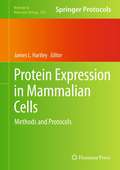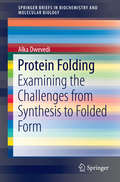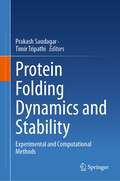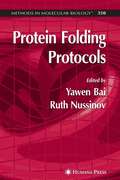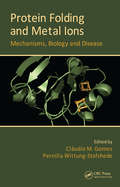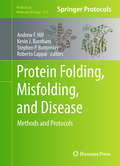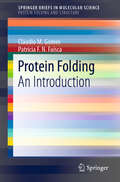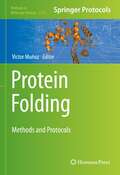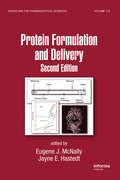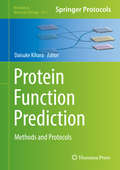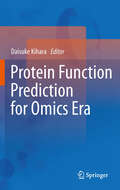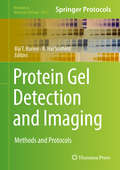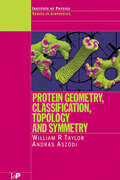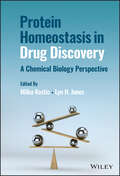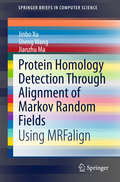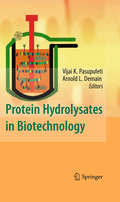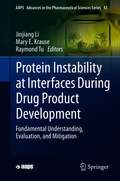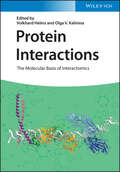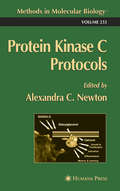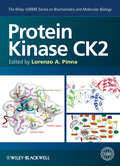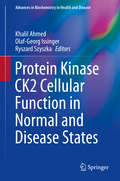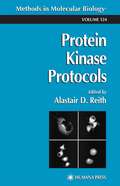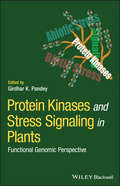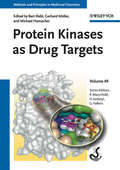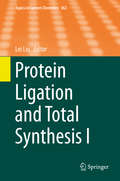- Table View
- List View
Protein Expression in Mammalian Cells
by James L HartleyThrough all of the recent progress provided by high throughput DNA sequencing technologies, it has become clearer and clearer that the study of proteins and protein organelles will be the key to unlocking our ability to manipulate cells and intervene in human disease. In Protein Expression in Mammalian Cells: Methods and Protocols, expert researchers in the field present a compendium of vital techniques to further our knowledge of mammalian protein expression. Written in the highly successful Methods in Molecular BiologyTM series format, chapters include introductions to their respective topics, lists of the necessary materials and reagents, step-by-step, readily reproducible laboratory protocols, and tips for troubleshooting and avoiding known pitfalls. Authoritative and concise, Protein Expression in Mammalian Cells: Methods and Protocols will aid scientists seeking to delve deeper into our own biology through the medium of other mammalian cells and proteins.
Protein Folding
by Alka DwevediThe book will discuss classes of proteins and their folding, as well as the involvement of bioinformatics in solving the protein folding problem. In vivo and in vitro folding mechanisms are examined, as well as the failures of in vitro folding, a mechanism helpful in understanding disease caused by misfolding. The role of energy landscapes is also discussed and the computational approaches to these landscapes.
Protein Folding Dynamics and Stability: Experimental and Computational Methods
by Timir Tripathi Prakash SaudagarThis book describes recent important advancements in protein folding dynamics and stability research, as well as explaining fundamentals and examining potential methodological approaches in protein science. In vitro, in silico, and in vivo method based research of how the stability and folding of proteins help regulate the cellular dynamics and impact cell function that are crucial in explaining various physiological and pathological processes. This book offers a comprehensive coverage on various techniques and related recent developments in the experimental and computational methods of protein folding, dynamics, and stability studies. The book is also structured in such a way as to summarize the latest developments in the fiddle and key concepts to ensure that readers can understand advanced concepts as well as the fundamental big picture. And most of all, fresh insights are provided into the convergence of protein science and technology. Protein Folding Dynamics and Stability is an ideal guide to the field that will be of value for all levels of researchers and advanced graduate students with training in biochemical laboratory research.
Protein Folding Protocols
by Yawen BaiCovering experiment and theory, bioinformatics approaches, and state-of-the-art simulation protocols for better sampling of the conformational space, this volume describes a broad range of techniques to study, predict, and analyze the protein folding process. Protein Folding Protocols also provides sample approaches toward the prediction of protein structure starting from the amino acid sequence, in the absence of overall homologous sequences.
Protein Folding and Metal Ions: Mechanisms, Biology and Disease
by Cláudio M. Gomes Pernilla Wittung-StafshedeThe role of metal ions in protein folding and structure is a critical topic to a range of scientists in numerous fields, particularly those working in structural biology and bioinorganic chemistry, those studying protein folding and disease, and those involved in the molecular and cellular aspects of metals in biological systems. Protein Folding an
Protein Folding, Misfolding, and Disease
by Andrew F. Hill Stephen P. Bottomley Roberto Cappai Kevin J. BarnhamProtein misfolding is a key feature of many disorders in humans, given that over twenty proteins are known to misfold and cause disease. In Protein Folding, Misfolding, and Disease: Methods and Protocols, experts in the field present a collection of current methods for studying the analysis of protein folding and misfolding, featuring strategies for expressing and refolding recombinant proteins which can then be utilized in subsequent experiments. This detailed volume also covers methods for analyzing the formation of amyloid, protocols for determining the size and structure of native and misfolded proteins, as well as specific examples of where misfolded proteins can be examined using state-of -the-art technologies. Written in the highly successful Methods in Molecular BiologyTM series format, chapters contain introductions to their respective topics, lists of the necessary materials and reagents, step-by-step, readily reproducible laboratory protocols, and key tips on troubleshooting and avoiding known pitfalls. Up to date and authoritative, Protein Folding, Misfolding, and Disease: Methods and Protocols offers researchers the tools necessary to move ahead in this vital field.
Protein Folding: An Introduction (SpringerBriefs in Molecular Science)
by Cláudio M. Gomes Patrícia F. N. FaíscaThis snapshot volume is designed to provide a smooth entry into the field of protein folding. Presented in a concise manner, each section introduces key concepts while providing a brief overview of the relevant literature. Outlook subsections will pinpoint specific aspects related to emerging methodologies, concepts and trends.
Protein Folding: Methods and Protocols (Methods in Molecular Biology #2376)
by Victor MuñozThis volume provides comprehensive protocols on experimental and computational methods that are used to study probe protein folding reactions and mechanisms. Chapters divided into five parts detail protein engineering, protein chemistry, experimental approaches to investigate the thermodynamics and kinetics of protein folding transitions, probe protein folding at the single molecule, analysis and interpretation of computer simulations, procedures and tools for the prediction of protein folding properties. Written in the format of the highly successful Methods in Molecular Biology series, each chapter includes an introduction to the topic, lists necessary materials and reagents, includes tips on troubleshooting and known pitfalls, and step-by-step, readily reproducible protocols. Authoritative and cutting-edge, Protein Folding: Methods and Protocols aims to be a useful practical guide to researches to help further their study in this field.
Protein Formulation and Delivery (Drugs and the Pharmaceutical Sciences)
by Eugene J. McNally Jayne E. HastedtThis title is intended to assist pharmaceutical scientists in the development of stable protein formulations during the early stages of the product development process, providing a comprehensive review of mechanisms and causes of protein instability in formulation development, coverage of accelerated stability testing methods and relevant analytica
Protein Function Prediction
by Daisuke KiharaGene function annotation has been a central question in molecular biology. The importance of computational function prediction is increasing because more and more large scale biological data, including genome sequences, protein structures, protein-protein interaction data, microarray expression data, and mass spectrometry data, are awaiting biological interpretation. Traditionally when a genome is sequenced, function annotation of genes is done by homology search methods, such as BLAST or FASTA. However, since these methods are developed before the genomics era, conventional use of them is not necessarily most suitable for analyzing a large scale data. Therefore we observe emerging development of computational gene function prediction methods, which are targeted to analyze large scale data, and also those which use such omics data as additional source of function prediction. In this book, we overview this emerging exciting field. The authors have been selected from 1) those who develop novel purely computational methods 2) those who develop function prediction methods which use omics data 3) those who maintain and update data base of function annotation of particular model organisms (E. coli), which are frequently referred
Protein Function Prediction for Omics Era
by Daisuke KiharaGene function annotation has been a central question in molecular biology. The importance of computational function prediction is increasing because more and more large scale biological data, including genome sequences, protein structures, protein-protein interaction data, microarray expression data, and mass spectrometry data, are awaiting biological interpretation. Traditionally when a genome is sequenced, function annotation of genes is done by homology search methods, such as BLAST or FASTA. However, since these methods are developed before the genomics era, conventional use of them is not necessarily most suitable for analyzing a large scale data. Therefore we observe emerging development of computational gene function prediction methods, which are targeted to analyze large scale data, and also those which use such omics data as additional source of function prediction. In this book, we overview this emerging exciting field. The authors have been selected from 1) those who develop novel purely computational methods 2) those who develop function prediction methods which use omics data 3) those who maintain and update data base of function annotation of particular model organisms (E. coli), which are frequently referred
Protein Gel Detection and Imaging: Methods and Protocols (Methods in Molecular Biology #1853)
by Biji T. Kurien R. Hal ScofieldThis volume expands upon the collection of techniques published in Protein Electrophoresis: Methods and Protocols (2012) with more practical and reproducible methods to study protein gel detection and imaging. The chapters in this book cover topics such as coomassie-brilliant blue staining of polyacrylamide gels; silver staining techniques; microwave assisted protein staining, de-staining, and in-solution digestion of proteins; curumin and turmeric as an environment-friendly protein gel stain; in-gel protein phosphotase assay using fluorogenic substrates; destaining with fungal laccase; and radiolabeling and analysis of labeled proteins. Written in the highly successful Methods in Molecular Biology series format, chapters include introductions to their respective topics, lists of the necessary materials and reagents, step-by-step, readily reproducible laboratory protocols, and tips on troubleshooting and avoiding known pitfalls.Comprehensive and practical, Protein Gel Detection and Imaging: Methods and Protocols is a valuable resource for expert and novice scientists and researchers who are interested in learning and experimenting with this field.
Protein Geometry, Classification, Topology and Symmetry: A Computational Analysis of Structure (Series in Biophysics)
by William R. Taylor Andras AszodiFrom a geometric perspective, this book reviews and analyzes the structural principals of proteins with the goal of revealing the underlying regularities in their construction. It also reviews computer methods for structure analysis and the automatic comparison and classification of these structures with an analysis of the statistical significance of comparing different shapes. Following an analysis of the current state of the protein classification, the authors explore more abstract geometric and topological representations, including the occurrence of knotted topologies. The book concludes with a consideration of the origin of higher-level symmetries in protein structure.
Protein Homeostasis in Drug Discovery: A Chemical Biology Perspective
by Milka Kostic Lyn H. JonesProtein Homeostasis in Drug Discovery Comprehensive resource on all aspects of protein homeostasis, covering both historical perspectives and emerging technologies that are revolutionizing the field Protein Homeostasis in Drug Discovery highlights drug discovery and development efforts targeting protein homeostasis and considers the emerging appreciation that a protein’s activity may not be the only factor to consider when developing therapeutic agents. The chapters cover various aspects of protein homeostasis such as cellular localization, abundance, interactions, and more. Moreover, the text contains up-to-date information regarding targeted protein degradation, an emerging drug discovery modality. Readers interested in targeting different regulatory events that control protein homeostasis or modulating protein abundance will find this book an excellent resource. Furthermore, those interested in the link between biological function and regulating protein levels in living organisms, especially in the context of drug discovery, will learn from numerous examples discussed in this book. In Protein Homeostasis in Drug Discovery, readers can expect to find information on: Protein folding, quality control, pharmacology, and drug targeting processes Recent advances in our understanding of protein homeostasis, covering emerging technologies and opportunities for therapeutic intervention Targeted protein degradation (TPD) and strategies such as PROTACs and molecular glues, including a chapter on TPD as an antiviral drug discovery strategy Drug discovery and development efforts aimed at correcting, stabilizing, and rescuing proteins, with examples included Advantages and key shortcomings of both phenotypic and target-based traditional drug discovery methods Collectively, Protein Homeostasis in Drug Discovery offers the reader an opportunity to learn more about the importance of considering and targeting protein homeostasis. The text is a must-read resource for academics, professionals in the pharmaceutical industry, and advanced students in various science-related fields.
Protein Homology Detection Through Alignment of Markov Random Fields
by Jinbo Xu Sheng Wang Jianzhu MaThis work covers sequence-based protein homology detection, a fundamental and challenging bioinformatics problem with a variety of real-world applications. The text first surveys a few popular homology detection methods, such as Position-Specific Scoring Matrix (PSSM) and Hidden Markov Model (HMM) based methods, and then describes a novel Markov Random Fields (MRF) based method developed by the authors. MRF-based methods are much more sensitive than HMM- and PSSM-based methods for remote homolog detection and fold recognition, as MRFs can model long-range residue-residue interaction. The text also describes the installation, usage and result interpretation of programs implementing the MRF-based method.
Protein Hydrolysates in Biotechnology
by Vijai K. Pasupuleti Arnold L. DemainThe protein hydrolysates industry is growing rapidly yet there is no single book that describes the challenges and opportunities for manufacturers and end users, techniques used in manufacturing, characterization and screening of protein hydrolysates, their applications in a wide variety of industries in biotechnology. One of the misconceptions in using protein hydrolysates in fermentations is that the end user believes and uses it as a mere nitrogen source. However, the functionality of the product obtained is not necessarily due to protein hydrolysates alone because it may not be a pure peptide or a combination of peptides and may contain carbohydrates, lipids, micronutrients, etc., present in the raw material used or sometimes the manufacturers deliberately add to the process to bring unique functionality. Only a handful of manufacturers dictate this market that tend to keep manufacturing process proprietary making it harder to understand. This book will close the gap by unfolding information on latest developments.
Protein Instability at Interfaces During Drug Product Development: Fundamental Understanding, Evaluation, and Mitigation (AAPS Advances in the Pharmaceutical Sciences Series #43)
by Jinjiang Li Mary E. Krause Raymond TuProteins are exposed to various interfacial stresses during drug product development. They are subjected to air-liquid, liquid-solid, and, sometimes, liquid-liquid interfaces throughout the development cycle-from manufacturing of drug substances to storage and drug delivery. Unlike small molecule drugs, proteins are typically unstable at interfaces where, on adsorption, they often denature and form aggregates, resulting in loss of efficacy and potential immunogenicity. This book covers both the fundamental aspects of proteins at interfaces and the quantification of interfacial behaviors of proteins. Importantly, this book introduces the industrial aspects of protein instabilities at interfaces, including the processes that introduce new interfaces, evaluation of interfacial instabilities, and mitigation strategies. The audience that this book targets encompasses scientists in the pharmaceutical and biotech industry, as well as faculty and students from academia in the surface science, pharmaceutical, and medicinal chemistry areas.
Protein Interactions: The Molecular Basis of Interactomics
by Volkhard HelmsProtein Interactions A fundamental guide to the burgeoning field of protein interactions From enzymes to transcription factors to cell membrane receptors, proteins are at the heart of biological cell function. Virtually all cellular processes are governed by their interactions, with one another, with cell bodies, with DNA, or with small molecules. The systematic study of these interactions is called Interactomics, and research within this new field promises to shape the future of molecular cell biology. Protein Interactions goes beyond any existing guide to protein interactions, presenting the first truly comprehensive overview of the field. Edited by two leading scholars in the field of protein bioinformatics, this book covers all known categories of protein interaction, stable as well as transient, as well as the effect of mutations and post-translational modifications on the interaction behavior. Protein Interactions readers will also find: Introductory chapters on protein structure, conformational dynamics, and protein-protein binding interfaces A data-driven approach incorporating machine learning and integrating experimental data into computational models An outlook on the current challenges in the field and suggestions for future research Protein Interactions will serve as a fundamental resource for novice researchers who want a systematic introduction to interactomics, as well as for experienced cell biologists and bioinformaticians who want to gain an edge in this exciting new field.
Protein Kinase C Protocols
by Alexandra C. NewtonThe first compilation of classic and emerging laboratory techniques for the study of the biochemistry and cell biology of protein kinase C (PKC). Described in step-by-step detail, these methods can be easily used to explore the structure, function, regulation, subcellular localization, and macromolecular interactions of protein kinase C.. Each protocol is introduced in the context of PKC function and regulation and contains many notes on how best to deal with the problems that may occur. Comprehensive and authoritative, Protein Kinase C Protocols is a timely compilation of biophysical, biochemical, cell biological, and molecular biological approaches that brings protein kinase C research into any laboratory interested in studying it.
Protein Kinase CK2
by Lorenzo A. PinnaProtein kinases play a critical role in cellular processes that impact overall organismal health and function. Of the kinases that collectively make up the Human Kinome, CK2 has garnered special attention because of its significant role in the generation of the human phosphoproteome. The role CK2 plays in the development of cancer and other disease has also made it of significant interest for its potential role in future therapeutics. Protein Kinase CK2 comprehensively brings together the varied work being done on this critical enzyme.Protein Kinase CK2 is logically divided into three sections. The first section reviews key molecular and structural aspects of the enzyme. The second section looks at functional aspects of CK2 and the diverse roles it plays in cellular development, function, and health. The final section focuses on CK2 and cancer, looking at the impacts of the kinase on neoplastic development and its rapidly developing role as a therapeutic agent.With contributions from the world's leading experts in the field, Protein Kinase CK2 will serve as an invaluable guide to the expanding and vibrant body of research being performed on this enzyme. This will be an essential volume for anyone working in the fields of biochemistry, protein science, signal transduction, metabolic regulation, and cancer biology and therapeutics.EditorLorenzo A. Pinna is Professor in the Department of Biomedical Sciences at the University of Padua, Padua, Italy.Also Published in the Wiley-IUBMB Series on Biochemistry and Molecular Biology:Plant Phenolics and Human Health: Biochemistry, Nutrition, and PharmacologyEdited by Cesar G. FragaISBN: 978-0-470-28721-7
Protein Kinase CK2 Cellular Function in Normal and Disease States
by Khalil Ahmed Olaf-Georg Issinger Ryszard SzyszkaProtein kinase CK2 (formerly casein kinase II or 2) is known to play a critical role in the control of cell growth and cell death and is thus intimately involved in the development of cancer. More specifically, CK2 has been found to be elevated in all cancers examined. While CK2 levels are known to be high in proliferating normal cells, CK2 has also been found to be a potent suppressor of apoptosis and is a link to the cancer cell phenotype, which is characterized by deregulation of both cell proliferation and cell death. Indeed, it would appear that CK2 impacts many of the hallmarks of cancer and it has now gained considerable attention as a potential target for cancer therapy. Protein Kinase CK2 and Cellular Function in Normal and Disease States increases knowledge of the role of CK2 in the development of cellular dysfunction and emphasizes that this protein may serve as a target of drug development for improved cancer therapy. In addition, it is a handy tool that provides cancer researchers, graduate students, and all scientists involved in CK2 research with one main source for the latest advances in CK2 research.
Protein Kinase Protocols
by Alastair D. ReithIn Protein Kinase Protocols, a panel of highly skilled laboratory investigators describe both basic and more sophisticated methods for the analysis of kinase-mediated signaling cascades, with emphasis on the identification of proteins according to their interactive relationships and the analysis of their functional properties. Described in step-by-step detail, these readily reproducible techniques offer novices quick access to a complicated field, and more experienced investigators many novel and time-saving ploys. Emphasis is given to critical technical steps that are often omitted from methods published in the primary literature. Broad in its range of techniques and thoroughly detailed to help ensure experimental success, Protein Kinase Protocols offers both novice and experienced investigators powerful tools for understanding the functional roles of specific protein kinases within signaling cascades and for identification and evaluation of novel therapeutic targets.
Protein Kinases and Stress Signaling in Plants: Functional Genomic Perspective
by Girdhar K. PandeyA comprehensive review of stress signaling in plants using genomics and functional genomic approaches Improving agricultural production and meeting the needs of a rapidly growing global population requires crop systems capable of overcoming environmental stresses. Understanding the role of different signaling components in plant stress regulation is vital to developing crops which can withstand abiotic and biotic stresses without loss of crop yield and productivity. Emphasizing genomics and functional genomic approaches, Protein Kinases and Stress Signaling in Plants is a comprehensive review of cutting-edge research on stress perception, signal transduction, and stress response generation. Detailed chapters cover a broad range of topics central to improving agricultural production developing crop systems capable of overcoming environmental stresses to meet the needs of a rapidly growing global population. This book describes the field of protein kinases and stress signaling with a special emphasis on functional genomics. It presents a highly valuable contribution in the field of stress perception, signal transduction and generation of responses against one or multiple stress signals. This timely resource: Summarizes the role of various kinases involved in stress management Enumerates the role of TOR, GSK3-like kinase, SnRK kinases in different physiological conditions Examines mitogen-activated protein kinases (MAPKs) in different stresses Describes the different aspects of calcium signaling under different stress conditions Examines photo-activated kinases (PAPKs) in varying light conditions Briefs the presence of tyrosine kinases in plants Highlights the cellular functions of receptor‐like protein kinases (RLKs) <li style="margin: 0in 0in 0.0001pt 0.25in; font-size: 11pt; font-family: Calibri, sans-serif; vertical-align: baseline; user-sele
Protein Kinases as Drug Targets (Methods and Principles in Medicinal Chemistry #49)
by Raimund Mannhold Gerd Folkers Hugo KubinyiThis timely guide to kinase inhibitor drug development is the first to cover the entire drug pipeline, from target identification to compound development and clinical application. Edited by the pioneers in the field, on the drug development side this ready reference discusses classical medicinal chemistry approaches as well as current chemical genomics strategies. On the clinical side, both current and future therapeutic application areas for kinase inhibitor drugs are addressed, with a strong focus on oncology drugs. Backed by recent clinical experience with first-generation drugs in the battle against various forms of cancer, this is crucial reading for medicinal, pharmaceutical and biochemists, molecular biologists, and oncologists, as well as those working in the pharmaceutical industry.
Protein Ligation and Total Synthesis II
by Lei LiuEach review within the volume critically surveys one aspect of that topic and places it within the context of the volume as a whole. The most significant developments of the last 5 to 10 years are presented using selected examples to illustrate the principles discussed. The coverage is not intended to be an exhaustive summary of the field or include large quantities of data, but should rather be conceptual, concentrating on the methodological thinking that will allow the non-specialist reader to understand the information presented. Contributions also offer an outlook on potential future developments in the field.
